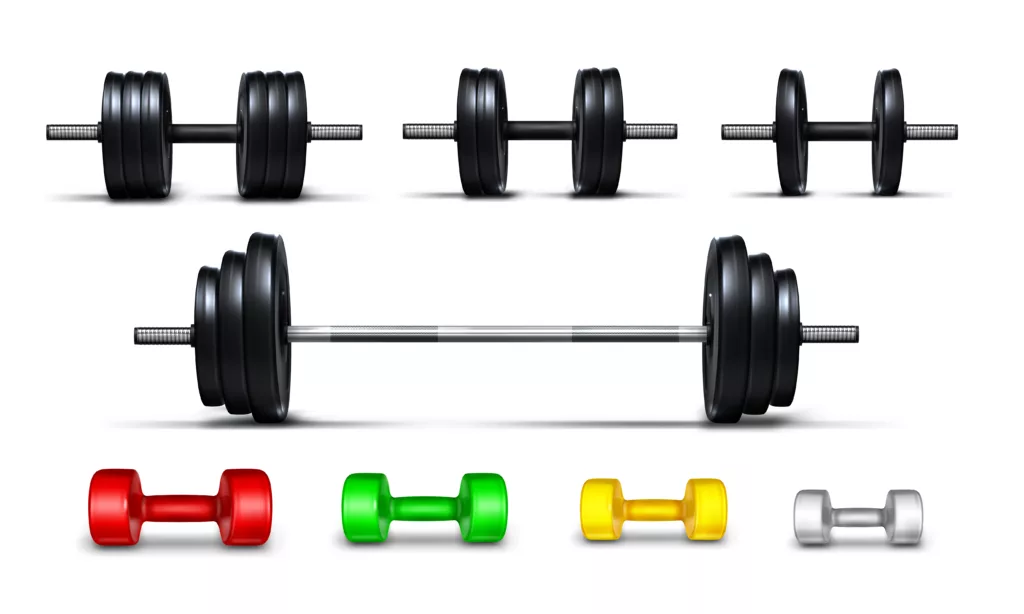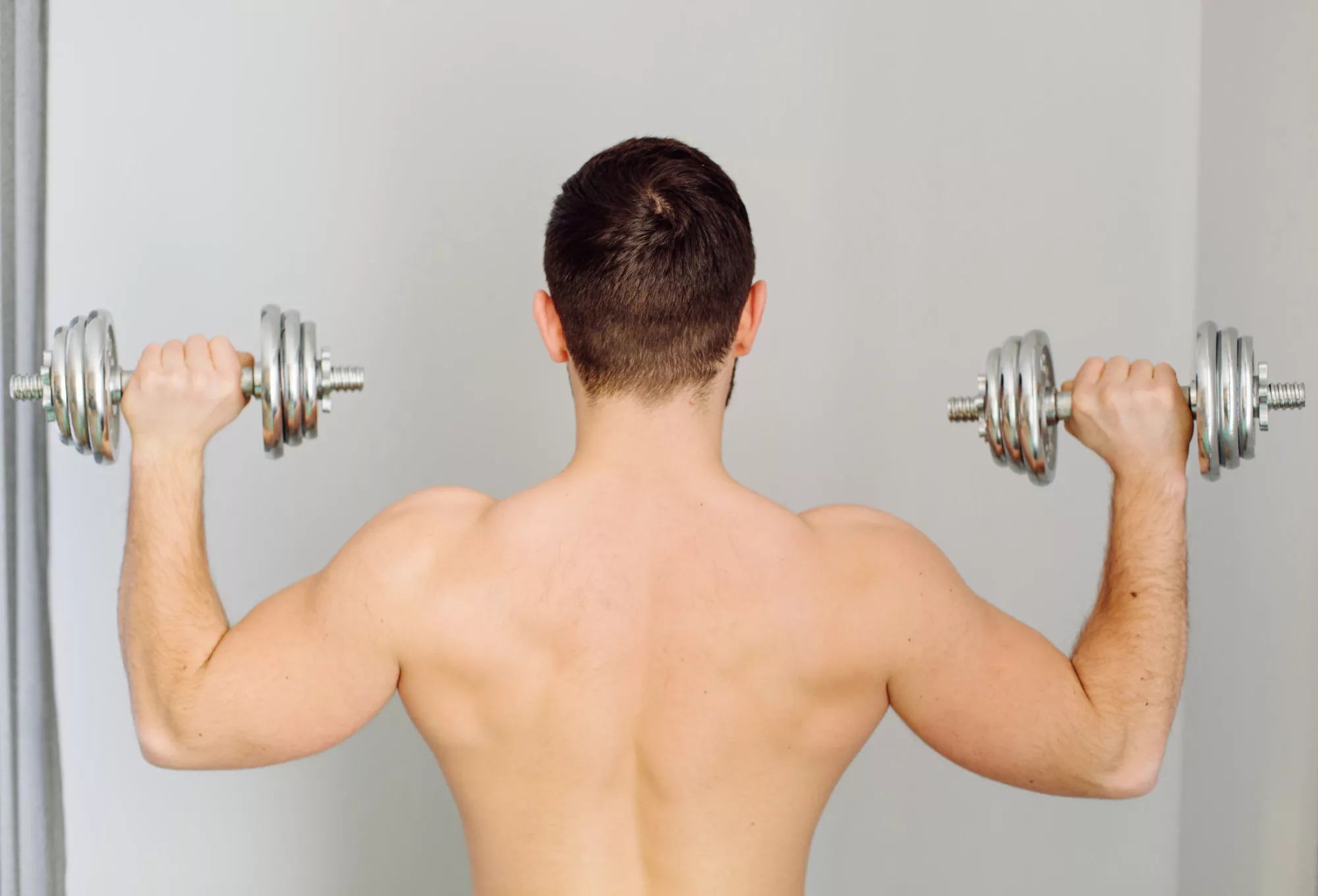Let’s keep it simple.
You stand in front of the mirror.
You grab the dumbbells.
You set your position.
You press them overhead.
And… nothing.
Your deltoids don’t seem to want to cooperate.
Then you pick up the barbell.
You press.
And your shoulders start working immediately as they should.
What’s going on?
Why do you feel your delts less with dumbbells?
Let’s explore together.
Dumbbells and Barbells: Not Two Sides of the Same Coin

Part one: Dumbbells and barbells are NOT interchangeable, as I once thought.
It’s not like choosing between Coke and Pepsi.
It’s more like choosing between riding a bike or driving a dirt bike: you move either way, but the experience is radically different.
When Lifting a Barbell Overhead
When you lift a barbell overhead:
- Your hands are locked in place.
- The movement is rigid, guided.
- Your body “locks in” into a super-stable setup, like a concrete bollard in the sidewalk.
With Dumbbells Instead?
With dumbbells, it’s total chaos.
Each arm is free to go wherever it wants.
You need control, you need stability, you need every secondary muscle to step in and keep things in order.
And guess what?
When your body has to stabilize, it siphons energy away from the main muscle you wanted to train — in this case, the beloved deltoids.
The Real Culprits: Stabilizer Muscles

Here’s the plot twist you didn’t expect while cursing the dumbbells.
When you do an overhead press with dumbbells, it’s not just about “push up and that’s it.”
It becomes a full-blown battle for motor control.
Why?
Because each arm is independent.
And when your limbs aren’t locked together (as they are with a barbell), your body automatically activates a series of stabilizer muscles — muscles that don’t directly generate force for the lift but work to keep joints and segments aligned.
Here’s who jumps in:
- Rotator cuff: This group of four muscles (supraspinatus, infraspinatus, teres minor, subscapularis) stabilizes the humeral head in the shoulder socket.
They’re like the ropes holding a sail steady in a storm.
With dumbbells, every tiny sideways or rotational shift forces the cuff to grind without rest. - Serratus anterior: It connects the ribs to the scapula and prevents the shoulder blade from “winging” out during the press.
Often overlooked, this muscle is crucial for scapulohumeral rhythm — how the scapula and humerus move smoothly together. - Middle and lower trapezius: They control scapular rotation and stabilization downward and inward, anchoring the shoulder blade as you press overhead.
If they don’t work well, the scapula “shrugs” up and the deltoid loses its leverage. - Deep core (transverse abdominis, multifidus, pelvic floor): Yes, it sounds like Pilates, but when you’re under two 30-kg dumbbells… if your core gives out, you fold like a coat hanger.
But with the Barbell? A Whole Different Story
When you use a barbell, your hands are fixed at the same distance.
This external constraint automatically stabilizes the system.
The shoulder has less freedom (and less need) for its own stabilization because the barbell acts like a mechanical guide.
It reduces unwanted degrees of freedom.
In practice:
- The rotator cuff works less.
- The scapula is forced into an efficient path.
- The core still works, but not like a Cirque du Soleil acrobat.
And above all:
The anterior and lateral deltoids can focus on the one thing they were meant to do: lift the weight.
The False Friend: Range of Motion

Another hidden issue: the movement path.
Theoretically, with dumbbells you can increase ROM — go deeper on the descent, press higher on the ascent…
But in practice?
Hardly anyone does it correctly.
Most of us (myself included, at least once a week) tend to:
- Bring the dumbbells too close at the top, almost like clinking glasses in a toast.
- Lose tension in the deltoid and transfer load to the triceps.
With the barbell instead:
- The ROM feels more natural.
- The load stays on the delts throughout the press.
Moral of the story:
With dumbbells, you risk wasting half of your training potential because of a sloppy lock-out.
Nervous System: The Invisible Puppeteer

Now, let’s get a bit technical, but trust me, it’ll help.
The true director of our strength isn’t the muscle alone — it’s the central nervous system.
When you press a barbell overhead:
- Your nervous system knows what to expect.
- The movement is stable, predictable.
- You get full activation of the target muscles.
When you switch to dumbbells:
- Every inch feels like a question.
“Is my left arm collapsing? Is my right rotating? Where’s the load going?”
Your nervous system goes into defense mode.
Less efficiency.
More hand-brake engagement.
Less explosion in the deltoids.
So? Should You Ditch Dumbbells?
No. Quite the opposite.
Dumbbells are gold for your long-term development:
- They teach you control.
- They strengthen every stabilizer.
- They correct left-right imbalances.
- They make your shoulder joints as solid as a vault.
Sure, they might not give you that instant “pump” you feel with a barbell…
But they build foundations that prevent injuries and make you stronger across the board.
How to Properly Perform the Overhead Dumbbell Press
If you really want to feel your deltoids working without bleeding energy everywhere, nail these fundamentals:
- Stable setup: Feet slightly wider than hip-width, knees soft (not locked), glutes engaged, core braced like a rock. You must become one with the ground.
- Start position: Dumbbells at shoulder height, elbows under wrists, forearms vertical like Roman columns.
- Press path: Imagine pushing the ceiling away from you, not just moving straight up. Movement should be powerful yet controlled, like launching a giant arrow.
- No clinking at the top: Keep a slight gap between the dumbbells at full lock-out, as if you’re trying to press two invisible walls apart.
- Controlled descent: Lower without tipping forward or letting elbows flare like spaghetti. Control every inch, like a precision landing on Mars.
- Neutral head, eyes forward: Don’t stare at the dumbbells — look ahead as if locking eyes with an opponent.
Every detail you dial in makes you feel more deltoid and less instability.
How to Feel the Delts More During Dumbbell Presses
- Never let the dumbbells touch at the top. Maintain shoulder-width spacing.
- Think “push outward,” as if you’re trying to expand the world.
- Control your tempo: press hard, lower slowly in slow-motion style.
- Keep elbows slightly flared, not glued to your torso.
- Pre-activate delts with light lateral raises before the main set.
- Feet planted, glutes engaged, core braced. You must be a statue.
Small tweaks = way sharper deltoid engagement.
Mistakes I Made (and Was Called Out On!)
Let me tell you how it really went, warts and all.
Early on, I thought I was a mini-Thor doing dumbbell presses.
In reality, I was more like a drunk trying to lift two wine barrels.
My Errors
- I clinked the dumbbells at the top like a bar toast.
Result? Lost tension, triceps in overdrive, delts retired early. - I hyperextended my back as if doing a yoga backbend.
Thought I was pressing more, but I was just overstressing my lower spine.
I got corrected by squeezing my glutes and keeping my chest “high but not peeled.” - I rushed the descent.
“Press hard, lower like you’re late,” I thought.
In reality, the slow descent is crucial for maintaining controlled tension on the delts. - I let my elbows flare too wide.
Like I wanted to take flight as a runaway kite.
In truth, you need elbows neither too wide nor glued to the torso.
With patience, miles of practice, and a few “educational insults” from seasoned friends, I fixed it all.
Now, every overhead press lands right where it should — in the heart of the deltoid.
Other Equally Effective Exercises to Overhead Dumbbell and Barbell Press
If you want variety without losing effectiveness (or if you have joint issues that make the traditional overhead tough), here are solid alternatives:
- Arnold Press:
A wider take on the dumbbell press that hits the front delts even harder and forces you to control the full ROM.
Start with palms facing you, then rotate as you press. - Push Press (barbell or dumbbells):
Uses a slight leg drive.
Lets you overload the deltoids more without overstressing the rotator cuff.
Preferred by weightlifters for moving massive loads. - Seated Dumbbell Press:
Eliminates many “escape routes” in the lower body.
Relies purely on delts and core.
Ideal if you struggle with lumbar hyperlordosis or want better isolation. - Landmine Press:
An angled press with one end of the barbell anchored to the floor.
A more natural shoulder path that reduces rotator cuff stress.
A godsend if overhead aggravates your shoulders. - Z Press:
Hardcore, sitting on the floor with legs extended.
No stability options — you’ll know in three seconds if your core is solid.
Brutal (in a good way) deltoid load.
RELATED:》》》 Are Overhead Presses Overrated for Shoulder Growth or Just Misused?
Conclusion
It’s not a war between barbell and dumbbells.
It’s a strategy.
Every tool has its moment.
Every technique has its purpose.
If you want football-shoulder delts, lift the barbell without fear.
If you want resilient, balanced shoulders ready for anything, use dumbbells smartly.
True growth comes to those who know how to alternate.
And you?
Do you prefer pressing with a barbell or with dumbbells?
Let me know in the comments, I’m curious what works best for you!

